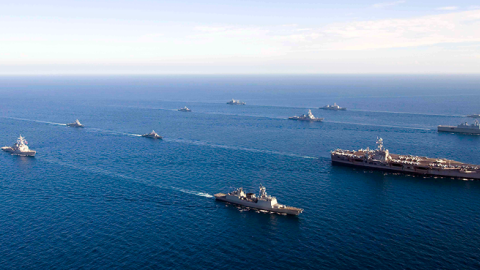At the end of March 2019, four Australian naval ships, including HMAS Canberra, an amphibious assault ship that is one of the two largest ever built for the Royal Australian Navy, called at ports in Colombo and Trincomalee in Sri Lanka. These warships will engage in the largest joint exercises ever conducted between Australia and India, in what will be Australia’s largest naval display since the Cold War.
In recent years, many such joint exercises have been held by the United States, Japan, India, Australia, and other nations in the Indo-Pacific region. These include RIMPAC (the Rim of the Pacific exercise, with Sri Lanka participating for the first time in 2018), Malabar (the USA, Japan, and India), Cope North (the USA, Japan, Australia, and other nations), Pitch Black (the USA, India, Australia, and other nations), KAKADU (the USA, Japan, India, Australia, and others, including Sri Lanka). These exercises appear to have promoted the informal Quadrilateral Security Dialogue, known as the Quad, among the United States of America, Japan, India, and Australia.
Despite these ongoing activities, in early March 2019, Adm. Phil Davidson, the head of the US Indo-Pacific Command, said the Quad might be shelved for now. The reason, he said, is that India has not clearly indicated its commitment.
What happened? Is the Quad dead? To understand the situation, we must answer three questions: What is the Quad? What is its purpose? Is it coming to an end, and if so, why?
What is the Quad? The initial impetus was the 2004 Indian Ocean earthquake and tsunami. The United States, Japan, India, and Australia dispatched naval ships to the region and cooperated on rescue operations. In 2007, Japanese Prime Minister Shinzo Abe initiated a security dialogue among the four countries. That same year, the four countries, along with Singapore, conducted naval exercises in the Bay of Bengal. These exercises were the first to be based on the Quad initiative.
The Quad
What is the purpose of the Quad? In 2007, Abe delivered an address to the Indian Parliament called ‘Confluence of the Two Seas’. He emphasised the importance of cooperation among the nations of the western Pacific and the Indian Ocean, setting out the basis for the Quad. In 2012, two days before he began his second term, he published ‘Asia’s Democratic Security Diamond’. This article clearly established the Quad as a counter-China strategy.
Eager to lay the groundwork for cooperation, Abe explained: “I spoke in India of the need for the Indian and Japanese Governments to join together to shoulder more responsibility as guardians of navigational freedom across the Pacific and Indian oceans. I must confess that I failed to anticipate that China’s naval and territorial expansion would advance at the pace that it has since 2007.” He continued: “I envisage a strategy whereby Australia, India, Japan, and the U.S. state of Hawaii form a diamond to safeguard the maritime commons stretching from the Indian Ocean region to the western Pacific.”
According to the 2018 white paper put out by Japan’s Ministry of Defence (‘Defence of Japan 2018’), China’s announced national defence budget for that year was approximately 2.7 times larger than in fiscal year 2008. Because of China’s rapid military modernisation, cooperation among the United States, Japan, India, and Australia is necessary to maintain military balance.
So, is the Quad dead? There are at least two reasons why it may end. First, even though the four countries share similar views toward China, there are some small perceptual differences. Indeed, 2019 is not the first time that these differences have emerged. In 2007 Australia elected a new Prime Minister, Kevin Rudd, who decided to withdraw from the Quad. Under Rudd, Australia did not see China as the threat that the other three countries perceived.
As the only one of the four countries to share a land border with China, India has a unique basis for assessing the threat. A land border is more sensitive than a maritime border. Moreover, India lost a war with China, in part over that same border, in 1962. Thus, compared with the other three countries, India’s threat perception tends to be higher, which may also make it more cautious.
The second reason why the Quad might not be maintained is that the four countries have other ways to promote cooperation. The Quad reemerged in November 2017 when high-ranking officials from the four countries gathered for the ASEAN summit in the Philippines, where they discussed the initiative. However, between 2007 and 2017, in the absence of the Quad, the four countries had continued to promote security cooperation along bilateral, trilateral, and multilateral lines. As this history suggests, the Quad is only one of many lanes of cooperation.
Therefore, the United States, Japan, India, and Australia have continued to promote cooperation, even if not under the name Quad. As in 2007 and 2017, the Quad will likely emerge again and again, like waves of the sea.



















